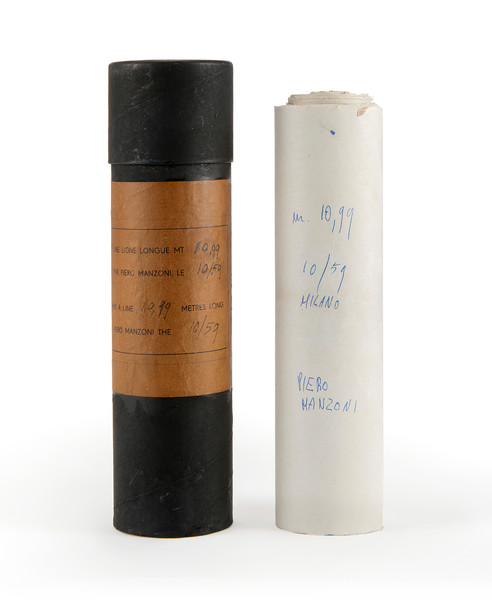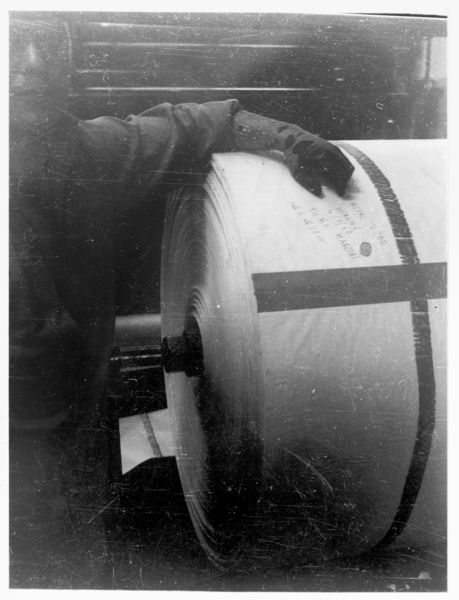Books
Piero Manzoni’s Lines

Piero Manzoni executing Linea lunga 7.200 metri (Line 7200 Meters Long). Herning, 1960 © Ole Bagger / HEART, Herning Museum of Contemporary Art © Eva Sørensen © Fondazione Piero Manzoni, Milano
Piero Manzoni’s 1959 exhibition ‘Le Linee’ at Azimut gallery in Milan, presented visitors with small, black cylinders, containing scrolls of paper with lines. Manzoni remarked ‘recently I executed a line of infinite length, but this also has its defect. You must keep the case perfectly closed, because if you open it, the line will disappear’. Lines, made usually in black ink, were a conceptual preoccupation of the artist’s, and he expanded their formal potential on scrolls of paper up to 7200 meters long. As part of Hauser & Wirth Publisher’s two-volume new release, ‘Lines’ delves into the eponymous body of work of fundamental importance to Manzoni’s well-known Achromes—paintings without color—which aimed to strip his work of expression. Extensively illustrated, ‘Piero Manzoni: Materials & Lines’ features art historical essays alongside a host of archival material, making this one of the most comprehensive sources on the artist to date. Below are textual excerpts from the second volume, including the editor’s annotations and one chapter from Jack McGrath’s essay ‘Along Different Lines: Manzoni by Comparison’.

Azimut Lines are essential for Manzoni. In his essays and letters he often writes how these artworks are as important as the Achromes. It is no coincidence that the first exhibition at Azimut—a space created and used by artists that was open for about a year—happened to be Linee (Lines) by Piero Manzoni. On December 4, 1959, on via Clerici, the artist presented twelve sealed tubes with an orange label and an unrolled line along the walls. The small exhibition catalogue featured a text by Vincenzo Agnetti. This was the perfect opportunity to shoot a sarcastic film for Filmgiornale SEDI, in which photographer and improvised actor Uliano Lucas pretends to buy a Linea and when he arrives at home immediately unrolls it, revealing the word capolinea–Italian for ‘terminus’ or ‘end of the line.’

Piero Manzoni, Linea m 10,99 (Line 10.99 Meters Long), October 1959 © Fondazione Piero Manzoni, Milano. Photo: Agostino Osio © Fondazione Piero Manzoni, Milano

Installation view, ‘Piero Manzoni. Lines’, Hauser & Wirth New York, 22nd Street, 2019 © Fondazione Piero Manzoni, Milano
Along Different Lines: Manzoni by Comparison by Jack McGrath The Baseline
Manzoni initiated the Lines project in the spring of 1959. Although the works would take on a few different forms, they all share in common the notion of the artistic mark –indeed of artistic labor itself – distilled to the production of a single, slender black grapheme in spatiotemporal extension. They were sold by the meter. Manzoni made Lines in a range of proportions, but the longest achieved the prodigious span of 7200 meters — that’s about four and half miles. Using a brush or roller, the artist would execute a long, continuous line on a long, continuous scroll of paper, which was then rolled up and enclosed in a black card- board tube. A manila label on each cylindrical container records the length of line, the date of production, and the signature of the artist. Pasted to their exterior, many tubes also include a sample segment of the line inside, in the manner of a decorator’s swatch or scientific specimen. Viewers must content themselves with label and sample, however, because Manzoni was emphatic that the Lines’ containers must remain forever closed. In a letter to a contact in Germany, for example, the artist insisted in all caps, ‘Important: THE CONTAINERS OF THE LINES ARE SEALED: DO NOT OPEN THEM, BUT DISPLAY AND SELL THEM LIKE THIS, IN CLOSED CONTAINERS. THEY ARE ABSOLUTELY NOT TO BE OPENED!’[1]

Piero Manzoni executing Linea lunga 7.200 metri (Line 7200 Meters Long). Herning, 1960 © Ole Bagger / HEART, Herning Museum of Contemporary Art © Eva Sørensen © Fondazione Piero Manzoni, Milano

For the first few exhibitions of the Lines, the artist did consent to ‘sacrifice’ an example, which was unrolled and exhibited horizontally across the walls of the gallery.[2] But questions of visibility and verifiability would remain issues of some controversy for the Lines, particularly for the subset of the series whose labels read ‘Linea di lunghezza infinita’ (Line of Infinite Length). Rather than card-board tubes, these are simple wooden cylinders painted black with orange labels. As Manzoni once wryly explained to a reporter, ‘Recently I executed a line of infinite length, but this also has its defect. You must keep the case perfectly closed, because if you open it, the line will disappear.’[3]


Manzoni also offered a line of Lines in a more traditional and visually accessible format: individual sheets of paper with a single horizontal mark traversing its center. It is to this category of Line that the American pseudomorphs bear the closest likeness. The fact that our American comparisons resemble this, the only sort of Manzoni line that consents to remain visible, means that already the Americans beg to be read in greater relation to their perceptual conditions and in less radical terms than Manzoni. This is not to say that they lack a conceptual, or indeed social or political dimension; abstractions like ‘form’ or ‘history’ can be said to inhere in more or less equal measure in any material artifact. But the comparative works in question do not approach the anti-aesthetic radicality of artworks that refuse ever to present themselves to visual apperception.
If we take the Lines’ insistence on visual withdrawal and aesthetic negation seriously, we would have to conclude that they have more in common with American works like John Cage’s 4’33 of 1952 (music composed only of rests) or George Brecht’s event scores (like Word Event of 1961, which can be realized in an infinite number of ways, visually or otherwise) than with some of the comparative pieces in this exhibition. On the other hand, unlike Cage and Brecht, whose related projects cede the specificities of fulfillment to the aleatory synaesthetic conditions of site or the individual caprice of spectator-participant, Manzoni is never indifferent to material aspects of his art. Concept and material unite in all his works, not in the form-function aesthetics of modernist practice, but in a comprehensive consideration of the social production both of the material forms themselves and of their cultural significance within a wider field of art and object circulation.
Shut away permanently in their containers, Manzoni’s most significant Lines amount to a series of cylinders. If we were to literalize a formalist reading in the manner of Judd, we might say that they look like, say, Jasper Johns’s Painted Bronze (Ale Cans) (1960) or Judy Chicago’s Movable Cylinders (1965) or, in a different way, Andy Warhol’s Campbell’s Soup Cans (1962). These comparisons are not actually as obtuse as they may sound, but as decoys, perhaps they are less enticing than works approximating the Lines qua lines. Automobile Tire Print, a 1953 collaboration between Robert Rauschenberg and John Cage, is incredibly close in form to an unrolled Line, but since it also connects on a conceptual level, it cannot properly be called a pseudomorph. Rauschenberg was also responsible for the Lines’ most important American precedent, the Erased de Kooning Drawing of 1953 — an equally radical negation of linear inscription that exists only insofar as it has become invisible.
A selection of archival imagery and texts by Luca Bochicchio, Flaminio Gualdoni, Gaspare Luigi Marcone and Jack McGrath are found in ‘Materials & Lines’, as part of a two volume book, available from Hauser & Wirth Publishers. Two concurrent exhibitions of work by Piero Manzoni, ‘Lines’ and ‘Materials of His Time’ are on display at Hauser & Wirth New York, 22nd Street, from 25 April – 26 July 2019.

[1] Unpublished letter from Manzoni to Jes Petersen. Archivio Piero Manzoni, Milan. Author’s translation.[2] The word ‘sacrifice’ is Manzoni’s. Of the line 19.93 m: ‘. . . l’ho sacrificata alle esigen-ze dimostrative, l’avevo svolta ed appesa alle pareti della Galleria ...’ Wladimiro Greco, ‘8 Domande al pittore Manzoni,’ Il Travaso (Milan), no. 39, October 5, 1959.[3] Greco, ‘8 Domande al pittore Manzoni.’ Author’s translation.
